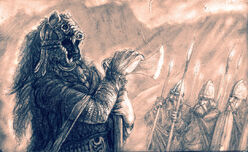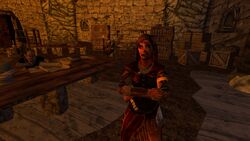No edit summary Tag: Visual edit |
HiddenVale (talk | contribs) (Lifespan entry is unnecessary. Read the article for the others.) Tag: Visual edit |
||
| (One intermediate revision by one other user not shown) | |||
| Line 1: | Line 1: | ||
| − | {{Race|name = |dominions = [[Dunland]]|languages = [[Westron]], [[Dunlendish]]|height =Generally tall, shorter than Dunadain on average |weigth = |skincolor = Tanned ruddy to olive brown, “swarthy” {{fact}}|haircolor = Brownish, dark, black, grayed, auburn, red {{fact}}|lifespan = |
+ | {{Race|name = |dominions = [[Dunland]]|languages = [[Westron]], [[Dunlendish]]|height =Generally tall, shorter than Dunadain on average |weigth = |skincolor = Tanned ruddy to olive brown, “swarthy” {{fact}}|haircolor = Brownish, dark, black, grayed, auburn, red {{fact}}|lifespan = |distinctions =Minimalistic clothes, tanned, barbaric, bitter {{fact}} |members = |title = Dunlendings|other_names = Wild Men|rivalries = |image = Dunlendings at Isengard.png}}[[File:Dunland_chief.jpg|thumb|248px|Dunlendings (by Merlkir of Deviantart)]]'''Dunlendings''', also known as the '''Wildmen of Dunland''', were the people of the plains of [[Dunland]]. They were known as a fierce culture of [[Men]], and sought vengeance on the people of [[Rohan]] who had driven them into the mountains. During the [[War of the Ring]], the wizard [[Saruman]] used their anger to manipulate and convince them to pillage the land of Rohan. |
== History == |
== History == |
||
| Line 30: | Line 30: | ||
== Portrayal in adaptations == |
== Portrayal in adaptations == |
||
| + | [[File:Dunlendings.jpg|alt=|thumb|215x215px|The Dunlendings at Isengard in ''[[The Two Towers (film)|The Two Towers]]'']] |
||
| − | |||
| − | [[File:Screen_shot_2010-03-22_at_7.28.47_PM.png|thumb|215x215px|A Chieftain of Dunland swearing allegiance to Saruman]] |
||
=== The Lord of the Rings films === |
=== The Lord of the Rings films === |
||
Revision as of 19:10, 10 May 2021

Dunlendings (by Merlkir of Deviantart)
Dunlendings, also known as the Wildmen of Dunland, were the people of the plains of Dunland. They were known as a fierce culture of Men, and sought vengeance on the people of Rohan who had driven them into the mountains. During the War of the Ring, the wizard Saruman used their anger to manipulate and convince them to pillage the land of Rohan.
History
In the years of the Second Age before the Númenóreans settled in Middle-earth, these tribal Hill-men inhabited the lands west and south of the Misty Mountains, as far down as the valleys surrounding the White Mountains.
Wary of the men who came out of the west, they came to fear and hate them. They were hunted and persecuted in such numbers that they had dwindled by the start of the Third Age. At this time they had come to congregate in the valleys of the White Mountains and the grassy plains of Dunland, which lay west of the Misty Mountains between Moria and Isengard; a few went north, and became the ancestors of the Men of Bree. Dunland then became the area most populated by these men, who came to be called Dunlendings.
In the eight hundred year period between the reigns of Tarannon Falastur and Tarondor, Dunland was technically part of Gondor, and the kings maintained garrisons to protect the North-South Road. These were withdrawn following the Great Plague in TA 1636 and afterwards as the garrisons at Angrenost and Aglarond dwindled the Dunlendings began to infiltrate eastwards into Calenardhon.
When Eorl and his people were granted Calenardhon --- Rohan, as it would later be known --- in TA 2510, they drove the Wild Men from their new lands, earning their bitter hatred and enmity. During the next five hundred years these shorter, dark-haired warriors made frequent attacks upon the outlying settlements of Rohan, exacting revenge upon the usurpers, whom they called "straw-heads" because of the high number of blond warriors among them. In alliance with the rebel lord Wulf the Dunlendings were able to almost completely overrun Rohan during the Long Winter of TA 2758-9, remaining in control of the West-March for over a century.
At some point near the end of the thirtieth century of the Third Age, Saruman made contact with them and swayed them to his side by playing on their resentment and hatred of those who had taken what was theirs. The Dunlendings began to trouble Rohan again during the reign of King Thengel, with the Rohirrim not realising that the attacks were orchestrated by Saruman.
Saruman welcomed to Orthanc a large warband of these Dunlendings prior to the War of the Ring. The Wizard evidently convinced them that they could reclaim what had been taken, and during the early part of TA 3019, a fearsome raiding force comprising Dunlendings and Orcs (especially Uruk-hai) left Isengard and began ravaging the western settlements of Rohan. Previous attacks by Orcs had killed many Rohirrim at the Battles of the Fords of Isen, which bought sufficient time for the populace to flee to the Hornburg and other refuges in the White Mountains.

Dunlending spearmen in the Third Age
After the defeat of Isengard at the Battle of the Hornburg, the Rohirrim spared the surviving Dunlendings and used them as workmen to repair the broken walls of the Hornburg.
The Rohirrim's mercy surprised the Dunlendings, as Saruman had convinced them the Rohirrim would slaughter them all if given the chance. When Gandalf, Frodo Baggins, Sam Gamgee, Merry Brandybuck, and Pippin Took were traveling through Dunland on their way back towards the Shire, the Dunlendings in that area hid from them. In the following decades Dunland was incorporated into the Reunited Kingdom.
Culture

Dunlendings in The Lord of the Rings Online
The Dunlending hill-folk were used to living in harsh conditions, often seen in leather garb and fur cloaks. They may have been related to the Snowmen of Forochel in the north. They were a tough, hardy people, big and powerful with long, unkempt hair and beards. The Dunlendings, because they lived in the hilly and forested area of Dunland, most likely hunted, foraged, and fished for food, with agriculture being a lesser form of food production.
They are once described as using cavalry, at the Fords of Isen. Their typical weaponry is not specified.
Portrayal in adaptations

The Dunlendings at Isengard in The Two Towers
The Lord of the Rings films
In Peter Jackson's The Lord of the Rings film trilogy, the men of Dunland are portrayed as a tribe of vile men who accept Saruman's offer to serve Sauron, by aiding him destroy the kingdoms of Men. They band together with Isengard Orcs and start raiding the villages of Rohan. In the extended version of The Two Towers, the Dunlending chieftain is seen making a blood oath to Saruman in the wizard's tower of Orthanc.
Wildmen of Dunland icon in BFME II
The Lord of the Rings: The Battle for Middle-earth II
The Dunlendings (named Wildmen of Dunland) are summonable units of Isengard or of the Goblin faction, from a 10-point power.
The Lord of the Rings Online
The Dunlendings appear as both enemies and allies in The Lord of the Rings Online, and, like most Hill-men in the game, are based loosely on Celtic tribes.
Translations
| Foreign Language | Translated name |
| Amharic | ዹንለንዲንግስ ? |
| Arabic | دنلندينغز |
| Armenian | Դւնլենդինգս ? |
| Belarusian Cyrillic | Дунлендінгс |
| Bengali | ডানব্লেন্ডিংস |
| Bulgarian Cyrillic | Дунлендингс |
| Burmese | ဍုန္လေန္ဒိင္သ္ |
| Catalan | Dunlendins |
| Chinese | 登蘭德人 |
| Croatian | Dunlendinzi |
| Dutch | Donkerlanders |
| Finnish | Mustainmaalaiset |
| Georgian | ძუნლენდინგსი |
| German | Dunländer |
| Greek | Δύνλενδινγς |
| Gujarati | ડનલેંડિંગ્સ |
| Hebrew | דונלנדינגס |
| Hindi | डनलेंडिंग्स |
| Hungarian | Dúnföldiek |
| Italian | Uomini del Dunland |
| Japanese | 褐色人 |
| Kannada | ಡನ್ಲೆಂಡಿಂಗ್ಸ್ |
| Kazakh Cyrillic | Дұнлендінгс |
| Korean | 갈색인 |
| Kyrgyz Cyrillic | Дунлэндингс |
| Macedonian Cyrillic | Дунлендингс |
| Malayalam | ഡണ്ലോന്ഡിംഗ്സ് |
| Marathi | डनलिंग्ज |
| Mongolian Cyrillic | Дунлэндингс |
| Nepalese | डुन्लेन्दिङ्स |
| Persian | دونلندینگها |
| Polish | Dunlendingowie |
| Punjabi | ਡਨਲੈਂਡਿੰਗਜ਼ |
| Russian | Дунландцы |
| Sanskrit | डुन्लेन्दिङ्स् |
| Serbian | Дунлендингс (Cyrillic) Dunlendings (Latin) |
| Sinhalese | ඩුන්ලෙඳිඞ්ස් |
| Spanish | Dunlendinos |
| Tajik Cyrillic | Дунлендингс |
| Tamil | டுணலெண்டிங்ஸ் |
| Telugu | దుంలెండింగ్స్ |
| Ukrainian Cyrillic | Дунлендінґс |
| Urdu | دنلاندنگس |
| Uzbek | Дунлендингс (Cyrillic) Dunlendings (Latin) |
| Yiddish | דונלענדינגס |
|
The People of Middle-earth
Men:
Edain | Dúnedain | Númenóreans | Haradrim | Easterlings | Variags | Northmen | Dunlendings | Drúedain | Forodwaith (Lossoth) Vanyar | Ñoldor | Teleri | Sindar | Nandor | Avari Durin's Folk | Firebeards | Broadbeams | Ironfists | Blacklocks | Stonefoots | Stiffbeards |
